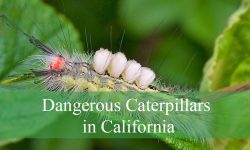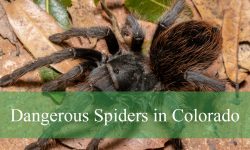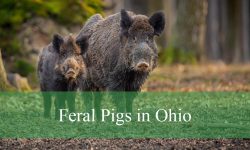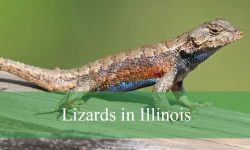Skunks are among the most fascinating mammals found in Virginia, well known for their distinct black-and-white appearance and their notorious ability to spray a foul-smelling musk when threatened. While they may have a bad reputation because of their defensive odor, these animals play an important ecological role by controlling insect populations and serving as prey for larger predators. Virginia is home to two distinct skunk species: the Striped Skunk (Mephitis mephitis) and the Eastern Spotted Skunk (Spilogale putorius putorius).
In this comprehensive guide, we’ll explore the features, identification tips, habitats, behaviors, and distributions of both species in Virginia. We’ll also include a comparison table, tips on where and when to see them, and a detailed look at their importance in the ecosystem.
Striped Skunk (Mephitis mephitis)

Characteristics and Identification
The striped skunk is the most familiar and widely distributed skunk species in Virginia. Roughly the size of a domestic cat, it measures between 18 and 32 inches in length, including the bushy tail, and typically weighs between 4 and 10 pounds. Its most recognizable feature is the bold white stripe that runs from the head down the back, usually splitting into two thinner stripes along the body. This striking pattern is an unmistakable warning sign to potential predators.
Its fur is long and coarse, with the black and white contrast serving as aposematic coloration—a visual warning of its powerful chemical defense. Unlike the spotted skunk, which has broken or irregular markings, the striped skunk’s stripes are continuous, making it easy to identify.
Size and Physical Traits
Adult striped skunks average around 2–3 feet in length, with males typically larger than females. Their tails can reach up to 15 inches long, adding to their overall appearance. They have short, strong legs equipped with long claws adapted for digging. Their head is relatively small compared to the body, with a pointed snout and small, rounded ears.
Behavior
Striped skunks are nocturnal and solitary for most of the year, except during mating season or when mothers are raising kits. They are opportunistic feeders, consuming a diet of insects, small mammals, eggs, fruits, and vegetation. They play an essential role in controlling pest insects, such as beetles, grubs, and grasshoppers.
Their most famous trait is their musk spray, produced by anal glands and released as a last-resort defense mechanism. Before spraying, striped skunks often give warning signs such as stamping their feet, raising their tail, and hissing. The spray can travel up to 15 feet and temporarily blind or disorient predators.
Habitat and Distribution in Virginia
Striped skunks are widespread throughout Virginia, occurring in both rural and suburban areas. They prefer open fields, forest edges, brushy habitats, and areas close to water. Because they adapt well to human presence, striped skunks are often found near farms, backyards, and even urban environments where food sources are abundant.
Two subspecies occur in Virginia: M. m. nigra in the eastern half and M. m. mephitis in the western portion of the state. Regardless of subspecies, their appearance and habits are nearly identical.
Breeding and Lifecycle
Mating occurs in late February to early March, with females giving birth to litters of 2–10 kits in May or June. Kits are born blind and helpless, opening their eyes at about 3 weeks old. By two months of age, they are able to follow their mother while foraging. Wild striped skunks typically live around 2–3.5 years due to predation, disease, and human encounters, though captive individuals may live longer.
Eastern Spotted Skunk (Spilogale putorius putorius)

Characteristics and Identification
The eastern spotted skunk is smaller and far more elusive than the striped skunk. About half the size of its cousin, it resembles a weasel in shape, with a slender body measuring 16–24 inches long and weighing only 1–3 pounds. Its distinctive pattern features broken white stripes, spots, and patches across its back, giving it a “spotted” appearance rather than continuous stripes. A small white patch often appears on the forehead.
This species’ pattern can vary between individuals, but the irregular markings make it easy to tell apart from the striped skunk. Its fur is silky and soft, contributing to its agile, slender appearance.
Size and Physical Traits
Eastern spotted skunks are the smallest skunks in North America. Their short legs are well-suited for climbing, and unlike striped skunks, they are known to scale trees when threatened. Their tails are proportionately shorter, but still bushy, measuring about 7–10 inches.
Behavior
One of the most unique behaviors of the eastern spotted skunk is its defensive handstand display. When threatened, it often stands on its front legs with its hindquarters raised in the air, sometimes stamping its feet before spraying. This behavior serves as a warning display to deter predators.
Eastern spotted skunks are primarily nocturnal and omnivorous, feeding on insects, rodents, birds, carrion, and fruits. Unlike the striped skunk, they are more secretive and difficult to observe, often avoiding areas of heavy human activity. They also climb trees with ease, making them more versatile in habitat use.
Habitat and Distribution in Virginia
The eastern spotted skunk has a more limited range in Virginia, found primarily in the Blue Ridge foothills and Appalachian Mountains. They prefer young forests, mature hardwood stands, brushy areas, and rocky outcrops with dense vegetation. Their secretive habits and declining population make them far less commonly seen than striped skunks.
The species is currently listed as a Tier IV species of greatest conservation need in Virginia and considered vulnerable due to population declines since the mid-20th century. Factors such as habitat loss, changes in land use, and increased predation are believed to have contributed to their decline.
Breeding and Lifecycle
Breeding occurs in late winter, with delayed implantation allowing kits to be born in late spring or early summer. Litters usually consist of 2–6 kits, which mature by late summer. In the wild, their lifespan is typically shorter than striped skunks, often less than 3 years, due to predation and other natural threats.
Comparison Table: Striped Skunk vs. Eastern Spotted Skunk
Feature |
Striped Skunk (Mephitis mephitis) |
Eastern Spotted Skunk (Spilogale putorius putorius) |
|---|---|---|
Size |
18–32 inches; 4–10 lbs |
16–24 inches; 1–3 lbs |
Appearance |
Continuous white stripes |
Broken stripes and spots; often a forehead patch |
Behavior |
Ground-dwelling; digs dens |
Agile climber; handstand defense display |
Distribution in VA |
Statewide, including suburban areas |
Western Virginia (Blue Ridge & Appalachian regions) |
Conservation Status |
Common, not at risk |
Vulnerable, declining population |
Breeding Season |
Feb–Mar; 2–10 kits |
Late winter; 2–6 kits |
Preferred Habitat |
Fields, edges, brushy areas |
Dense forests, rocky outcrops, understory cover |
Human Interaction |
Adaptable to suburbs and farms |
Avoids humans, very secretive |
Where to Find Skunks in Virginia
Striped Skunk
Striped skunks are widespread and can be seen throughout Virginia. They are most commonly observed in fields, along woodland edges, and even in suburban neighborhoods. Because they are highly adaptable, they often forage near trash bins, gardens, or pet food left outdoors. Rural areas with mixed farmland and forest provide particularly good habitats.
Eastern Spotted Skunk
Eastern spotted skunks are more elusive. If you want to increase your chances of spotting one, head toward the western parts of Virginia, particularly the Blue Ridge Mountains and Appalachian foothills. Look for them in areas with dense understory, brushy thickets, and rocky habitats. Their nocturnal and secretive habits make sightings rare, but they are occasionally detected by wildlife researchers using trail cameras.
Best Time of Year to See Skunks in Virginia
Both species are nocturnal and most active at night, so your best chance of observing them is after dusk. The breeding season in late winter and early spring increases activity levels, especially for striped skunks as they travel more widely in search of mates.
Spring and summer are good times to see striped skunks with their young, often foraging together. Autumn is also an active season, as skunks feed heavily in preparation for winter. Unlike true hibernators, skunks enter a state of torpor during the coldest months but may emerge on warmer nights to forage.
For eastern spotted skunks, there is no particular season that guarantees sightings, as they are rare and elusive year-round. However, late spring and summer, when young begin foraging with their mothers, may slightly increase chances of observation.
Skunks and Humans in Virginia
Skunks, particularly striped skunks, sometimes come into conflict with humans. They may raid garbage cans, dig up lawns in search of grubs, or take shelter under porches. Their spray makes them unwelcome visitors, but it’s important to remember their ecological role. By consuming insects and rodents, they help control pest populations that can harm crops and gardens.
Eastern spotted skunks are much less likely to cause issues due to their rarity and secretive behavior. Instead, they are of greater concern for conservationists, who are working to study and protect their dwindling populations.
If you encounter a skunk in Virginia, it’s best to admire it from a distance. Avoid startling or cornering the animal, as this increases the likelihood of being sprayed. Skunks are generally non-aggressive and prefer to avoid conflict whenever possible.
FAQs about Skunks in Virginia
What types of skunks live in Virginia?
Virginia is home to two skunk species: the Striped Skunk and the Eastern Spotted Skunk. Both can be found in different habitats across the state, though striped skunks are far more common and widespread.
How can I identify a skunk in Virginia?
Striped skunks are easily recognized by their black fur with bold white stripes running down the back, while Eastern spotted skunks are smaller with broken white spots and stripes across their bodies. Both species have bushy tails and a distinctive waddling walk.
Are skunks in Virginia dangerous?
Skunks are generally not aggressive and prefer to avoid conflict. However, they can spray a foul-smelling musk if threatened, and they may carry diseases like rabies, so it is best to keep a safe distance.
Where do skunks usually live in Virginia?
Skunks in Virginia thrive in forests, grasslands, farmlands, and even suburban neighborhoods. They often den in hollow logs, burrows, rock crevices, or under decks and porches.
What do skunks eat in Virginia?
Skunks are omnivores with a varied diet. In Virginia, they feed on insects, small mammals, birds’ eggs, fruits, nuts, and garbage left by humans. Their adaptable diet helps them survive in many environments.
When are skunks most active in Virginia?
Skunks are nocturnal and most active during the night. They typically forage for food from dusk until dawn and spend the day resting in their dens.
Can skunks be a problem for homeowners in Virginia?
Yes, skunks can become a nuisance when they dig up lawns in search of insects or when they den under homes and sheds. Their spray is also a concern if they feel cornered by pets or people.
How can I keep skunks away from my property in Virginia?
To prevent skunks, secure trash cans, eliminate pet food left outdoors, seal openings under buildings, and install fencing if necessary. Motion-activated lights can also discourage them from entering yards.
Do skunks hibernate in Virginia?
Skunks do not fully hibernate, but they enter a state of torpor during very cold winter months. They remain mostly inactive and may share dens with other skunks to conserve warmth.
What should I do if I encounter a skunk in Virginia?
Stay calm and keep your distance. Do not try to scare or corner the skunk, as it may spray. If one is on your property, give it space to leave on its own, or contact local wildlife control for assistance






